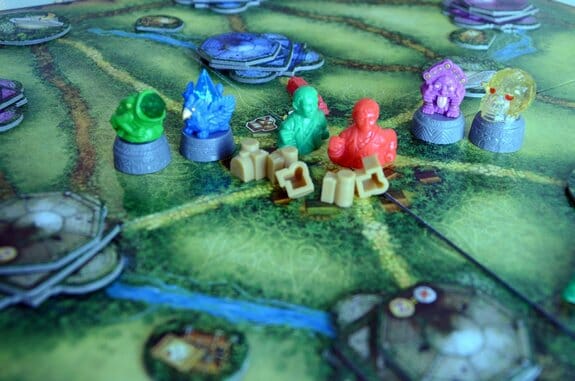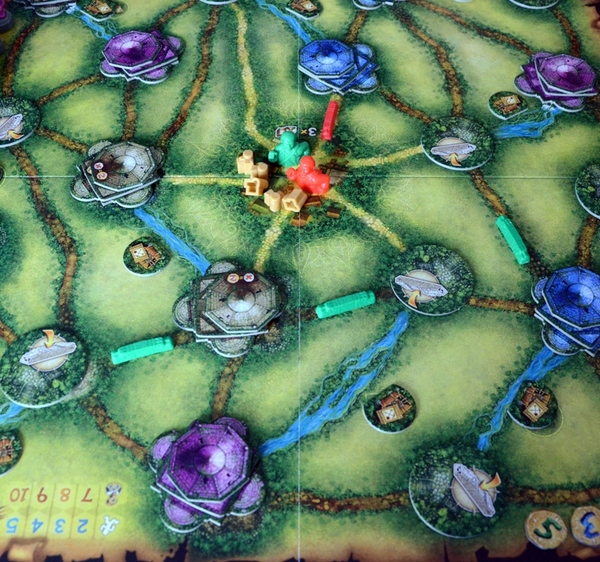
A new game from publisher Days of Wonder is always news because of their track record in the Eurogame space, including Small World and the crossover hit Ticket to Ride, both of which have spawned numerous successful expansions as well. Days of Wonder’s latest release, Relic Runners, shares some superficial characteristics with those games, including big, bold graphics and a fun theme, but the play itself isn’t as elegant and it’s too easy for a player to end up falling hopelessly behind in the second half of the game. Although gameplay isn’t divided into formal phases, it progresses from pathbuilding in the first half of a session to relic recovery in the second, adding a long-term planning element that isn’t explicit in the rules: You have to lay enough paths around the board to set yourself up for rapid recovery of those relics to avoid losing the game by a huge margin.
In Relic Runners, players act as explorers delving deep into a jungle filled with ruins and temples, hoping to be the first to uncover and claim the relics of the game’s title. Relics are worth victory points at the end of the game, and collecting one of each color is worth 20 points in a game where the winner will often be in the 50-70 range. The game board has 22 spaces for structures, eight ruins and fourteen temples, the latter divided across three different types which are distinguished by color. In a three- or four-person game, structures comprise three tiles in a stack, while in a two-person game the stacks contain just two tiles apiece. Players move around the board, laying down their own pathways on the printed ones on the board, which allows for free movement on later turns, and removing one tile at a time from any structure on which they land. When a stack is depleted, the space is filled with a relic of the same color – but a player can only retrieve it by traveling from one relic to another, both in the same color. When a player retrieves that relic, s/he gets a bonus for using his/her own pathways to do it, which can easily run to 8 to 12 points for one move.
Relic Runners also employs individual progress charts for players where they can gain small benefits like free pathway placement or relocation or immediate points bonuses. Some river paths on the board have toolbox tokens beside them, and the first player to cross that path may move one of his toolboxes up a space on his progress card. Each temple tile also provides a benefit to the player who uncovers and takes it, ranging from immediate point bonuses on blue temple tiles to recurring benefits on ivory temple tiles.
Because Relic Runners has no money element, explorers use ration packs as their currency, spending one to uncover any temple or ruin tile, returning to the central Base Camp space to replenish their supplies. There are some temple tiles and progress chart spaces that allow for additional ration packs, but in most cases players will have to keep one eye on their distance from Base Camp and waste a turn to go back and gain three new packs so they can continue exploring. While that fits the game’s theme, it does nothing to increase competitiveness, only punishing players who get sloppy and move themselves more than a single turn away from the board’s center, so for most players it is nothing more than a hassle with no way to make the turn more productive.
The hybrid structure of Relic Runners, combining a pathbuilding game with the development charts found in games like Goa or Bora Bora, means it’s both more complex than Days of Wonder’s two best-known titles, and also makes it very hard for a player to catch up in the latter half of the game if s/he hasn’t laid down the right pathways in the first part. There aren’t enough ways to place new paths—uncovering a ruin tile is the main method, and when doing so, a player can only place a pathway next to that ruin space—so if you haven’t placed enough paths, or placed them in the right spots, you’re up a creek. This also introduces a planning element that makes the game harder for younger players; my seven-year-old daughter, who enjoys Ticket to Ride and Carcassonne, liked Relic Runners but didn’t see the value in placing pathways in specific spots and patterns.
A full game of Relic Runners takes about an hour to 75 minutes for a three-person game, including the time to set up the board, most of which is in shuffling the temple tiles and placing them in the proper order. The game ends after the number of relics collected equals the number of players plus five, followed by the scoring, where players earn five points for each color of relic s/he’s collected, points earned during the game on blue temple tiles and from traversing his/her own pathways on relic expeditions, and from other bonuses such as those found on ivory temple tiles. The winner will typically have all four relic colors plus a pile of victory point tokens from building and using long pathways on one half of the board which allow him/her to collect those relics, which comes back to what I feel is Relic Runners’ biggest flaw: If you don’t play it right early, you won’t be able to catch up late.
Keith Law is a senior baseball writer for ESPN.com and an analyst on ESPN’s Baseball Tonight. You can read his baseball content at search.espn.go.com/keith-law and his personal blog the dish, covering games, literature, and more, at meadowparty.com/blog/.
